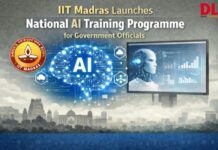
VR education is a new era of personalised learning. VR technology has a long way to go and has a bright future in the education sector. VR has already given reason to the industry to embrace it, as it is revolutionising every sector, writes Dave Dolan, Chief Knowledge Officer, Veative Labs, for Elets News Network (ENN).
VR in the classroom is a hot topic these days, fresh on the lips of enthusiastic instructors and neophyte teachers alike. However, this new-ish device is fraught with a painful and potentially expensive learning curve, and an industry pointing teachers in one direction. Is that direction, a teacher-centric, teacher-lead model of classroom usage, the right way to go? Let’s take a closer look.
The teacher of today has been bombarded with a slew of “new tech” in the past two decades, ranging from PC’s in the classroom, to tablets, robotics, coding programs and so on. They have also been introduced to a new, four letter word… just. The edtech industry thrives on this word, with a deep-seated feeling that if teachers would just learn a bit of coding, they will be fine. How often have weary teachers heard “you just need to sign up the class for this program” or “you just need to have each student buy this app” or “you just need to make learning objectives and assessments for this wonderful VR experience?” It can all be rather overwhelming, and rightly raises the guard of every well-intentioned instructor, looking for ways to bolster learning.
But let’s look at what the reality is for teachers the world over, regardless of VR or other tech options. Teachers, and schools, are often faced with the same challenges, everywhere:
- Increased class sizes
- Unmotivated students
- Varying levels and abilities within the same class
- Different learning styles within the same class
- Limited time and resources
- Managing a classroom, while also incorporating more individual learning
- Prep time bleeding into evenings and weekends
Teachers just need to deal with these points, and more!
It is without a doubt that introducing the VR into schools can engage and motivate students to learn, but unfortunately that can never be enough. It is too valuable of a tool to be used as a teacher-led, passive experience, taken out of the box only when a teacher finds the time to set it up and feels motivated to work through an experience with the class. This is missing the point of the power of virtual reality, and the deeper dive into learning that it can promote: hence the need for personalised learning using the VR.
The VR is a uniquely personal experience, and should be used as such. If providing a distraction-free environment which promoted focused concentration on a subject was the only benefit to VR, then that alone might be enough to justify using this tool. But again, it must be used in ways far beyond these simple, yet important features. So how can the VR help teachers (yes, teachers!), and why should we approach VR as a necessary part of the educational process?
The VR is a device that students have a natural curiosity about, and a desire to use. We never have a problem getting them interested in using the VR. This very simple fact means that a young learner is coming into the device with an open and curious mind, which is the best starting point for learning to happen. An open and enthusiastic mind, in a distraction-free environment means that there is a far greater chance to get to higher order thinking skills (HOTS), which are always more difficult to learn, and to teach. When you add in experiential learning, learning by doing, then the process is that much more effective, and powerful. Interactive STEM modules promote such learning.
Why is this important for the teacher? Because managing large, varied classes often means generalising the delivery of content. When a student can go off on their own and discover new ideas and connect with complex concepts on their own conversely means that the delivery of content becomes much more personalised for that individual. As long as the teacher is connected with this learning, which she is through analytics, then there is power and agency bestowed upon the learner.
All of this is possible only if a system has been designed with the teacher in mind. At Veative, the teacher is not only included in the process, but is front and center. This can only happen if certain things are done, and championed:
- A wealth of interactive content for students to delve into
- Content which has the minimum requirements for teachers, which means it must possess: learning objectives, attention to a core concept and assessment (all within the environment)
- Curriculum alignment
- Localised to that region (voice and text in the native language)
- A simple dashboard from which to glean student data, and class-wide results
- Assessment questions, inside the VR environment, tagged all the way down to cognitive domain
- The ability to run a classroom Lab (all students on one task), if desired
- Self-paced, self-directed learning opportunities for all students
- Useful for Spec Ed and the most challenging students (can be used as a reward)
This should constitute the bare minimum from the view of teacher expectations, when thinking about VR in the classroom.
We know that VR can take students to places they cannot normally go, such as the Eiffel Tower or Burj Khalifa. But more importantly, the VR can take learners into places that the teacher cannot, such as into a plant to experience photosynthesis, or to within centimeters of a working combustion engine. But the burden cannot rest on the shoulders of a teacher to just learn about VR, do the prep work and run a class using this tool. Agency is better given to students to work at their own pace, in a judgement-free environment, free from the prying eyes of fellow students, who don’t need to know that you needed to do the module on Charles Law three times before you fully understood it. That should be between the student and the teacher, where it belongs. A properly designed VR learning system would allow, and promote, such interaction.
























